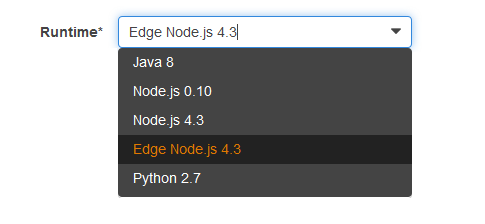AWS News Blog
Lambda@Edge – Preview
Just last week, a comment that I made on Hacker News resulted in an interesting email from an AWS customer!
He told me that he runs a single page app that is hosted on S3 (read about this in Host Your Static Website on Amazon S3) and served up at low latency through Amazon CloudFront. The page includes some dynamic elements that are customized for each user via an API hosted on AWS Elastic Beanstalk.
Here’s how he explained his problem to me:
In order to properly get indexed by search engines and in order for previews of our content to show up correctly within Facebook and Twitter, we need to serve a prerendered version of each of our pages. In order to do this, every time a normal user hits our site need for them to be served our normal front end from Cloudfront. But if the user agent matches Google / Facebook / Twitter etc., we need to instead redirect them the prerendered version of the site.
Without spilling any beans I let him know that we were very aware of this use case and that we had some interesting solutions in the works. Other customers have also let us know that they want to customize their end user experience by making quick decisions out at the edge.
It turns out that there are many compelling use cases for “intelligent” processing of HTTP requests at a location that is close (latency-wise) to the customer. These include inspection and alteration of HTTP headers, access control (requiring certain cookies to be present), device detection, A/B testing, expedited or special handling for crawlers or ‘bots, and rewriting user-friendly URLs to accommodate legacy systems. Many of these use cases require more processing and decision-making than can be expressed by simple pattern matching and rules.
Lambda@Edge
In order to provide support for these use cases (and others that you will dream up), we are launching a preview of Lambda@Edge. This new Lambda-based processing model allows you to write JavaScript code that runs within the ever-growing network of AWS edge locations.
You can now write lightweight request processing logic that springs to life quickly and handles requests and responses that flow through a CloudFront distribution. You can run code in response to four distinct events:
Viewer Request – Your code will run on every request, whether the content is cached or not. Here’s some simple header processing code:
exports.viewer_request_handler = function(event, context) {
var headers = event.Records[0].cf.request.headers;
for (var header in headers) {
headers["X-".concat(header)] = headers[header];
}
context.succeed(event.Records[0].cf.request);
}Origin Request – Your code will run when the requested content is not cached at the edge, before the request is passed along to the origin. You can add more headers, modify existing ones, or modify the URL.
Viewer Response – Your code will run on every response, cached or not. You could use this to clean up some headers that need not be passed back to the viewer.
Origin Response – Your code will run after a cache miss causes an origin fetch and returns a response to the edge.
Your code has access to many aspects of the requests and responses including the URL, method, HTTP version, client IP address, and headers. Initially, you will be able to add, delete, and modify the headers. Soon, you will have complete read/write access to all of the values including the body.
Because your JavaScript code will be part of the request/response path, it must be lean, mean, and self-contained. It cannot make calls to other web services and it cannot access other AWS resources. It must run within 128 MB of memory, and complete within 50 ms.
To get started, you will simply create a new Lambda function, set your distribution as the trigger, and choose the new Edge runtime:
 Then you write your code as usual; Lambda will take care of the behind-the-scenes work of getting it to the edge locations.
Then you write your code as usual; Lambda will take care of the behind-the-scenes work of getting it to the edge locations.
Interested?
I believe that this cool new processing model will lead to the creation of some very cool new applications and development tools. I can’t wait to see what you come up with!
We are launching a limited preview of Lambda@Edge today and are taking applications now. If you have a relevant use case and are ready to try this out, please apply here.
You can find out more on December 16th by joining our webinar. Register here.
— Jeff;